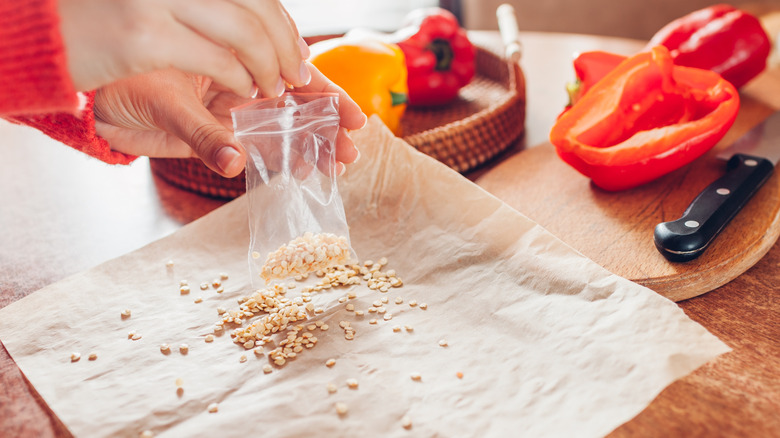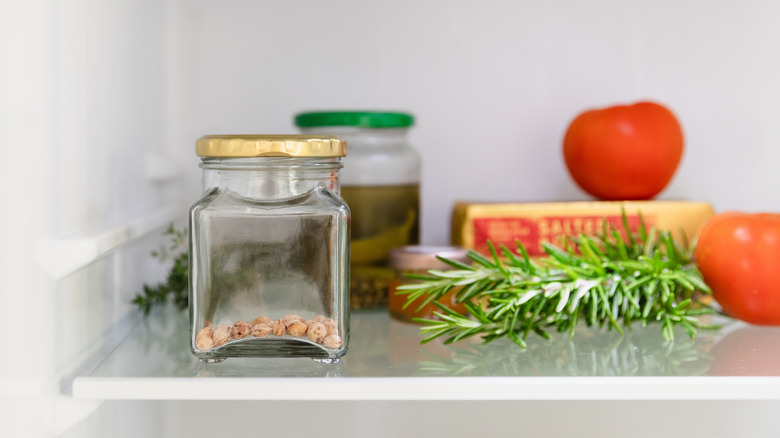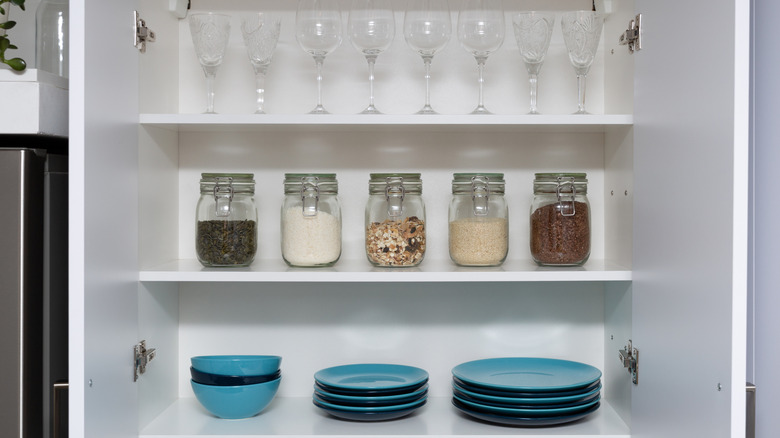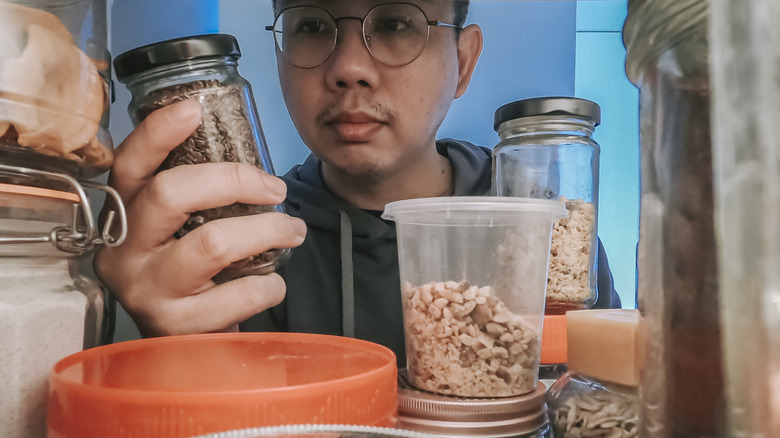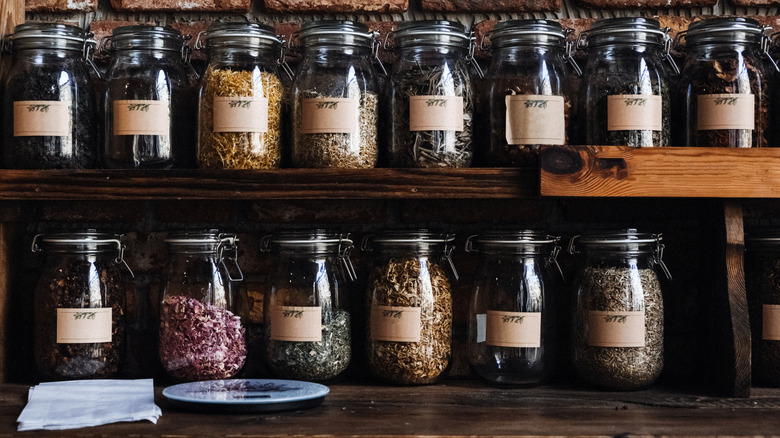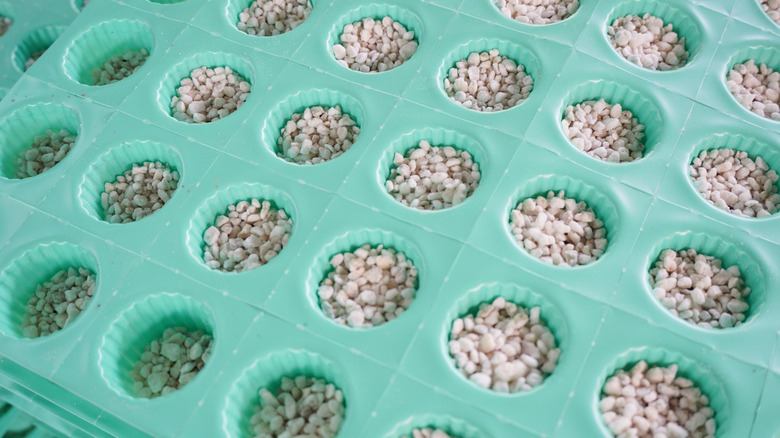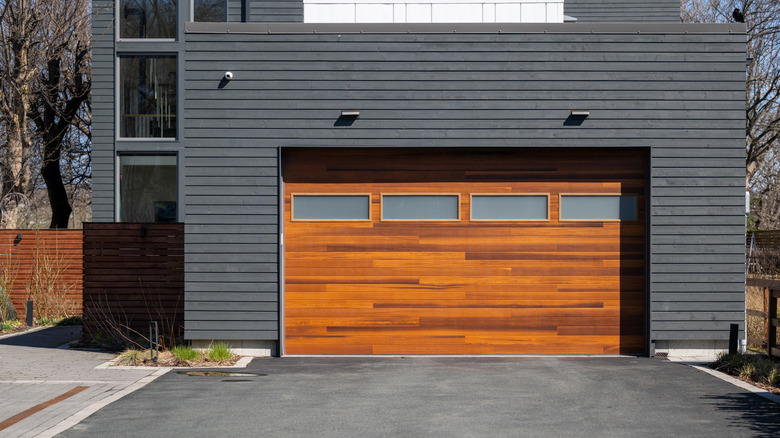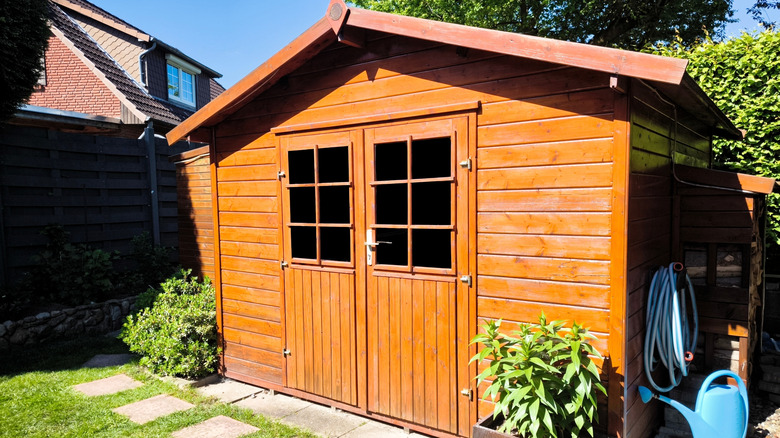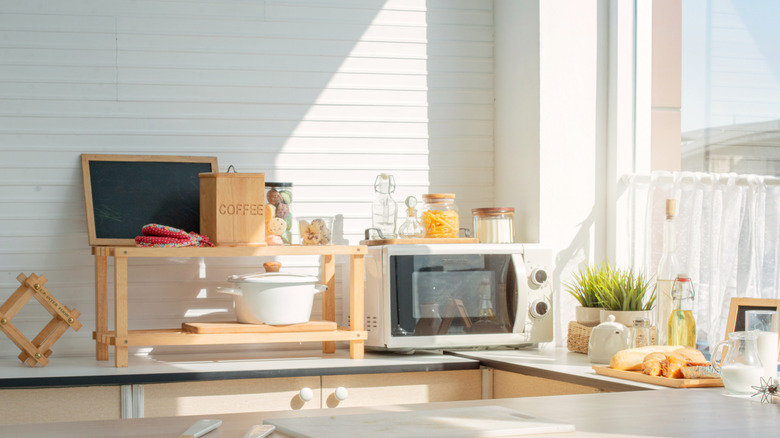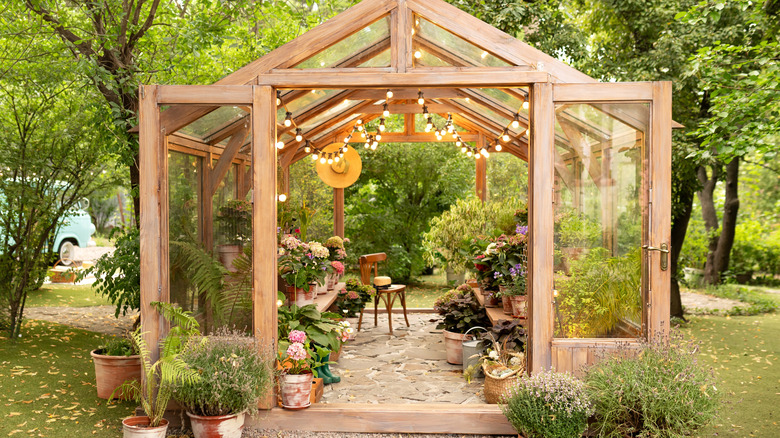The Best Places To Store Seeds (And Ones You Should Absolutely Avoid)
So you've had a successful harvest in your flower or vegetable garden — congratulations! But as the growing season winds down, it's time to start wrapping things up in your yard. But does that mean the party is over? Not at all — especially if you take the time to collect and store your bounty's seeds. Seeds can stay viable for years if dried and then kept away from light, heat, and humidity. While we wish everyone were lucky enough to score the ultimate seed storage solution from a thrift store, we know card catalogs aren't exactly easy to come by. So for the rest of us, we've got to find the right space to store our stash.
Unfortunately, not every place is great for protecting your seeds during their dormancy. Even the most ideal spaces will need a few tweaks to ensure your seeds remain viable. That's why we've pulled together the best places to store seeds that can maintain them for as long as you need. Plus, we've also included a few spots that might seem like good places at first, but can actually do damage to your collection faster than you think. Break out the seed envelopes, and let's dive in.
Your fridge's cool temps are perfect for seed storage
Refrigerators are one of the most popular options that can keep garden seeds fresh for years. They're awesome because nearly everyone has one, they're cool enough to keep seeds dormant, their temperatures stay constant, and the plethora of shelves and drawers pretty much ensure you'll find a good spot for your seeds to sit undisturbed. Fridges are also great for when you need to cold stratify seeds, so it's almost like a one-stop germination shop that can both hold dormant seeds and encourage new seedlings to grow.
Moisture and light are the two biggest issues you'll have to deal with when storing seeds in the fridge. The inside of a refrigerator can get pretty humid, so you'll need storage options that prevent moisture from seeping in. Opt for airtight containers made of glass or metal; you can even reuse old glass jars for seed storage to save money if the seals are still in tact. The interior light that pops on when the door opens might also be an issue, though we haven't seen many people complaining about it. If you've got seeds that really matter to you, though, and want to play it safe, use opaque or semi-opaque containers to reduce as much light exposure as possible.
A kitchen cupboard that's far from the stove keeps seeds dark and dry
If fridge space is hard to come by, a spot in one of your kitchen cabinets could work really well. Kitchen cupboards are awesome for seed storage because they're typically completely opaque and prevent UV light from hitting your seeds. Plus, since you're in your kitchen often, you can keep an eye on your seeds to ensure mold or fungi don't secretly take hold of your harvest. Just be sure not to leave the door open too long, exposing your seeds to light.
There are a few considerations you'll need to be mindful of if you go with a kitchen cabinet. First, only use cabinets that have solid doors (no glass fronts) — remember that we want the seeds to stay in as dark a spot as possible. Next, skip the cabinets that are under the sink or near the dishwasher to prevent the chance for moisture to enter the containers. Make sure the containers are airtight, too, just in case. Finally, don't use the cabinets above or around the stove. The heat from the stove or oven might affect the temperature of the cupboard, while steam coming off of the cooked food might affect the humidity.
Want to store seeds for the long term? Use your freezer
What if you harvest an absolute mega-load of seeds that you won't be able to completely use for years? Freeze them! Many types of seeds can remain viable for nearly a decade of being frozen and it's actually the way many mega seed banks store their collections. The famous Svalbard Global Seed Vault in Norway keeps its collection of over 1.3 million seed samples at approximately zero degrees Fahrenheit, and they seem to be doing just fine.
Moisture control is the main thing you'll need to deal with if storing your seeds in a freezer. Use only airtight containers, and consider using opaque options instead of transparent. The color of the container might not be a huge deal, but we like to hedge our bets and reduce the seed's access to light as much as possible. That interior light that comes on every time the door is open might not be a big deal, but we'd rather be safe than sorry. If you've got an airtight metal container that can fit your seeds, that would be perfect.
Root cellars have the consistent temperature dormant seeds need
We feel like it's almost common sense that root cellars would make good places for seed storage, right? If it's good enough for roots, then it's good enough for seeds. Root cellars are perfect places for seeds — and roots, obviously — because they stay cool and dark nearly year-round.
That said, you may run into the occasional moisture issue, especially if your root cellar is pretty old. Make sure your seeds are in airtight containers like glass jars. Plastic or polyethylene bags also work well, but can trap moisture if not sealed properly, so you may want to use them for smaller seed harvests and then throw multiple bags into a glass jar with a desiccant and close it tightly. Also, keep your seeds on a shelf instead of on the ground to prevent them from getting eaten by the rare wayward critter or being affected by moisture in the dirt if your floor is bare.
Don't have a root cellar? Your basement will do just fine
We know that root cellars are a bit antiquated these days, but don't worry, because you've most likely got a great alternative: your basement. Since basements are usually the part of your house that's closest to the ground, they're typically nice and cool with low humidity,just like your seeds need. Plus, their conditions stay so stable that any fluctuation would rarely be drastic enough to affect seed viability. If you're living in an apartment or condo building, you're not out of luck just yet. Check to see if your building offers storage lockers in the basement so that you can take advantage of all the good stuff they can do for seed storage.
A few things to consider, though, before you start tossing your seeds downstairs. First, make sure your basement is completely sealed or your containers are critter-proof so that rodents can't sneak in to eat your seed stash. Next, opt for a spot that's far away from your furnace, water heater, and washer and dryer to limit changes to the heat or humidity around your seeds. Finally, consider keeping your seeds off the ground to save them in case of flooding, and pop a desiccant in your containers as a failsafe. You don't need to head out to buy a bunch of those silica packets, either; an envelope of powdered milk or rice make excellent and cheap alternatives for removing moisture–though they are not as long-lasting as silica. Keep an eye on them to assure they don't spoil.
Even a dark closet can make a perfect seed storage spot
If your home doesn't have many spots that stay consistently dark, even popping your seeds into a dark corner of your closet can work well. Since most closets are windowless, there's little chance of UV light hitting your seeds, and they usually maintain a cool, consistent temperature with low humidity. Just to be sure, though, you'll probably want to put your seeds closer to the closet's floor than ceiling so that they stay cool and dry. Plus, using your closet will give you an excuse to head out and get new organizers that create more storage space. It's not your fault you spent money on a cool closet organizing system from IKEA, you're doing it for the seeds!
Before deciding to use some free space in a closet, consider what's underneath it first. If the closet isn't on the first floor, it's possible that the room underneath it could make things problematic. A bathroom or kitchen, for example, could push moisture up and add to the humidity, while being near an air vent or furnace could result in the occasional puff of hot air hitting the seeds, especially if the closet isn't insulated. Take a look around the space and ensure that there aren't any outside forces at play that could accidentally ruin your seed collection.
Some seeds can be safely stored right in vermiculite
Let's say you live in a home where there's no basement or root cellar, and fridge, freezer, and closet space is at a premium — does that mean you're out of luck? Not necessarily, especially if you're storing a particular type of seed. Some seeds need the smallest smidge of moisture to remain viable and won't germinate if allowed to completely dry out. For these, a cheap and super modular option is a bag of vermiculite. Vermiculite is often added to potting mixes to help moisture retention so storing moisture-critical seeds in a small bag full of it can be the perfect way to keep them viable. Plus, it's usually pretty cheap and available at most nurseries or big box stores.
So which seeds can work with this method? While this isn't a definitive list, walnuts, oaks, and magnolias, are all recalcitrant seeds, which need some moisture to germinate. However, you don't want to overdo the moisture and make your vermiculite bag a moldy mess, so add just a few drops of water before adding your seeds. Make sure the seeds stay completely covered so that they don't accidentally germinate, then seal the bag shut and store it in a cool, dark place.
Skip the garage due to their fluctuating temperatures
Attached or freestanding garages are deceptively poor spots for storing seeds. We get why it might seem counterintuitive; your garage is probably pretty cold throughout the year and doesn't get a ton of light. But, garage doors are not well-insulated, so it's hard to maintain a consistent temperature. Also, many garage doors have small windows that let light in, ruining your chance to create the dark atmosphere seeds need. Plus, garages can get more humid than you think, especially during the summer months.
If you need an alternative, consider the way you get from your garage into your home. Likely, there's some sort of transitional place like a mud room, breezeway, or basement. While breezeways with lots of windows might have some issues, they can be tweaked by adding a small cupboard to the darkest spot of the north side wall (but more on that later). Just stick your seeds on the bottom shelf, then keep the cupboard closed until you're ready to sow. Foyers and mudrooms could also be useful for seed storage, especially if they're windowless. If your garage access door immediately opens into the kitchen or another room and there's no transition space, opt for storing seeds in a closet or cupboard instead.
Sheds are just too problematic for long-term seed storage
Sheds have a laundry list of problems that make them bad options for keeping your seeds safe. While your shed probably stays relatively dark while it's closed up for the season, like garages, they are poorly insulated. And, if you've got windows on your shed, that makes it even more difficult to keep the cool, consistent temperature that you'll need for successful seed dormancy. Sheds also are rarely completely sealed, so all of those cracks and crevices make it easy for the occasional critter to move in and munch on your seeds while you're none the wiser.
Keeping your seeds somewhere safe from rodents or bugs most likely means stashing them close to home, literally. Having your seed hoard in your home instead of a shed means you'll be able to better monitor and protect them from light, temperature changes, humidity, and hungry animals.
Leaving seeds out in the open in kitchens or bathrooms can mess with their viability
Collecting seeds in cute vintage jars or decorative containers and displaying them out in the open might look awesome, but it's sucking the life out of your seeds. Not only will the light exposure limit their viability, but think about the room where they might have the most aesthetic appeal — probably the kitchen, right? This spot is a humidity haven that can harbor fungi or mold growth, both of which are seed killers. Any room that gets a relative humidity of 60 percent or more is not a spot to store your seeds.
So, instead, keep your seeds tucked away. As we mentioned earlier, a dark cupboard in your kitchen that's far away from the stove should work just fine. That said, a bathroom cupboard probably won't work just because of how humid every spot in that room can get. Regardless, using jars of seeds as decor pieces like in this image will most likely mean that's where your seeds have to stay — because they won't ever germinate after a season on the shelf.
Avoid storing seeds on the south side of your home because the temperature is typically too volatile
Did you know that the White House's famous portico faces south? If you think about it, it makes sense why: the south side of a building typically receives the most sunlight during the day so it's great for natural light photo ops. And while you and the President might love feeling that warmth and sunshine, your seeds are not big fans. Since rooms on a building's south-facing side receive the most sun exposure, they'll get hotter than the other rooms positioned on the sides or north parts. The rising temperatures will make it hard for you to maintain a consistent cool temperature for your seeds, even in a dark closet or cupboard.
If the south part of your home is the only place you've got, then try to get your seed storage as low to the ground as possible. Heat rises, so shoot for your basement or the floor of a closet; this could help maintain a more consistent temperature and prevent your seeds from getting too hot to remain viable. Also, pay attention to the humidity level of the room and consider getting a dehumidifier. Even small, portable ones like this 35 Oz Small Dehumidifier by TABYIK can help if placed closely to the spot where your seeds are spending their off season. However, your best bet is to stash seeds on the north side of your home if at all possible. North sides typically have a more consistent temperature since they get less light exposure.
Your greenhouse might seem like the perfect spot, but it gets too hot for seeds to stay dormant
A dreamy greenhouse can definitely transform your backyard, but their function makes them one of the worst places possible for seed storage. Think about it: Successful seed storage requires a spot that's cool, dark, and dry. Have you ever seen a greenhouse that looked or felt like that? Neither have we. While it would be nice to have everything stored in one central place for your plants and garden, the truth is that greenhouses create the polar opposite of the environment your seeds need.
Unfortunately, there's probably not a compromise here; even using an airtight, opaque container may still become too warm because of the greenhouse effect and could possibly accumulate condensation around the seeds. Instead, use your greenhouse the way it was intended: to create a humid, warm, and bright spot that tells baby plants and seedlings it's safe to germinate. Both your growing plants and dormant seeds will be happier that way.
